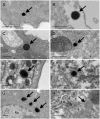Ultrastructural, Cytochemical, and Comparative Genomic Evidence of Peroxisomes in Three Genera of Pathogenic Free-Living Amoebae, Including the First Morphological Data for the Presence of This Organelle in Heteroloboseans
- PMID: 32602891
- PMCID: PMC7549135
- DOI: 10.1093/gbe/evaa129
Ultrastructural, Cytochemical, and Comparative Genomic Evidence of Peroxisomes in Three Genera of Pathogenic Free-Living Amoebae, Including the First Morphological Data for the Presence of This Organelle in Heteroloboseans
Erratum in
-
Erratum to: Ultrastructural, Cytochemical, and Comparative Genomic Evidence of Peroxisomes in Three Genera of Pathogenic Free-Living Amoebae, Including the First Morphological Data for the Presence of This Organelle in Heteroloboseans.Genome Biol Evol. 2021 Aug 3;13(8):evab180. doi: 10.1093/gbe/evab180. Genome Biol Evol. 2021. PMID: 34418059 Free PMC article. No abstract available.
Abstract
Peroxisomes perform various metabolic processes that are primarily related to the elimination of reactive oxygen species and oxidative lipid metabolism. These organelles are present in all major eukaryotic lineages, nevertheless, information regarding the presence of peroxisomes in opportunistic parasitic protozoa is scarce and in many cases it is still unknown whether these organisms have peroxisomes at all. Here, we performed ultrastructural, cytochemical, and bioinformatic studies to investigate the presence of peroxisomes in three genera of free-living amoebae from two different taxonomic groups that are known to cause fatal infections in humans. By transmission electron microscopy, round structures with a granular content limited by a single membrane were observed in Acanthamoeba castellanii, Acanthamoeba griffini, Acanthamoeba polyphaga, Acanthamoeba royreba, Balamuthia mandrillaris (Amoebozoa), and Naegleria fowleri (Heterolobosea). Further confirmation for the presence of peroxisomes was obtained by treating trophozoites in situ with diaminobenzidine and hydrogen peroxide, which showed positive reaction products for the presence of catalase. We then performed comparative genomic analyses to identify predicted peroxin homologues in these organisms. Our results demonstrate that a complete set of peroxins-which are essential for peroxisome biogenesis, proliferation, and protein import-are present in all of these amoebae. Likewise, our in silico analyses allowed us to identify a complete set of peroxins in Naegleria lovaniensis and three novel peroxin homologues in Naegleria gruberi. Thus, our results indicate that peroxisomes are present in these three genera of free-living amoebae and that they have a similar peroxin complement despite belonging to different evolutionary lineages.
Keywords: Acanthamoeba; Balamuthia; Naegleria; diaminobenzidine; peroxin content; transmission electron microscopy.
© The Author(s) 2020. Published by Oxford University Press on behalf of the Society for Molecular Biology and Evolution.
Figures




Similar articles
-
Atomic force microscopic imaging of Acanthamoeba castellanii and Balamuthia mandrillaris trophozoites and cysts.J Eukaryot Microbiol. 2015 Jan-Feb;62(1):85-94. doi: 10.1111/jeu.12147. Epub 2014 Sep 3. J Eukaryot Microbiol. 2015. PMID: 25041405
-
Molecular identification of waterborne free living amoebae (Acanthamoeba, Naegleria and Vermamoeba) isolated from municipal drinking water and environmental sources, Semnan province, north half of Iran.Exp Parasitol. 2017 Dec;183:240-244. doi: 10.1016/j.exppara.2017.09.016. Epub 2017 Sep 13. Exp Parasitol. 2017. PMID: 28916458
-
Potentially pathogenic genera of free-living amoebae coexisting in a thermal spring.Exp Parasitol. 2018 Dec;195:54-58. doi: 10.1016/j.exppara.2018.10.006. Epub 2018 Oct 26. Exp Parasitol. 2018. PMID: 30393165
-
Pathogenic free-living amoebae: epidemiology and clinical review.Pathol Biol (Paris). 2012 Dec;60(6):399-405. doi: 10.1016/j.patbio.2012.03.002. Epub 2012 Apr 18. Pathol Biol (Paris). 2012. PMID: 22520593 Review.
-
Pathogenic and opportunistic free-living amoebae: Acanthamoeba spp., Balamuthia mandrillaris, Naegleria fowleri, and Sappinia diploidea.FEMS Immunol Med Microbiol. 2007 Jun;50(1):1-26. doi: 10.1111/j.1574-695X.2007.00232.x. Epub 2007 Apr 11. FEMS Immunol Med Microbiol. 2007. PMID: 17428307 Review.
Cited by
-
Delineating transitions during the evolution of specialised peroxisomes: Glycosome formation in kinetoplastid and diplonemid protists.Front Cell Dev Biol. 2022 Sep 12;10:979269. doi: 10.3389/fcell.2022.979269. eCollection 2022. Front Cell Dev Biol. 2022. PMID: 36172271 Free PMC article.
-
Acanthamoeba castellanii exhibits intron retention during encystment.Parasitol Res. 2022 Sep;121(9):2615-2622. doi: 10.1007/s00436-022-07578-5. Epub 2022 Jul 1. Parasitol Res. 2022. PMID: 35776211
-
Application of the omics sciences to the study of Naegleria fowleri, Acanthamoeba spp., and Balamuthia mandrillaris: current status and future projections.Parasite. 2021;28:36. doi: 10.1051/parasite/2021033. Epub 2021 Apr 12. Parasite. 2021. PMID: 33843581 Free PMC article. Review.
References
-
- Aghajani A, Dabirzadeh M, Maroufi Y, Hooshyar H.2016. Identification of Acanthamoeba genotypes in pools and stagnant water in ponds in Sistan region in Southeast Iran. Turkiye Parazitol Derg. 40(3):132–136. - PubMed
-
- Almagro Armenteros JJ, Sønderby CK, Sønderby SK, Nielsen H, Winther O.2017. DeepLoc: prediction of protein subcellular localization using deep learning. Bioinformatics 33(21):3387–3395. - PubMed
-
- Almagro Armenteros JJ, et al.2019. SignalP 5.0 improves signal peptide predictions using deep neural networks. Nat Biotechnol. 37(4):420–423. - PubMed
-
- Altschul SF, Gish W, Miller W, Myers EW, Lipman DJ.1990. Basic local alignment search tool. J Mol Biol. 215(3):403–410. - PubMed
Publication types
MeSH terms
Substances
LinkOut - more resources
Full Text Sources

